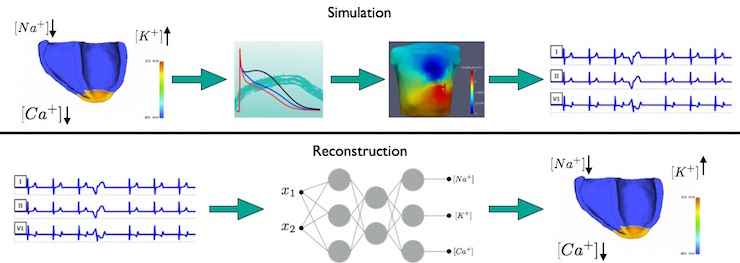Characterization and reconstruction of ionic concentrations in the human ventricles analyzing the action potential and the surface ECG
- Typ:Masterarbeit
- Betreuung:
- Bearbeitung:
-
Motivation
The maintenance of physiological levels of ionic concentrations in the body plays a decisive role in the therapy of different diseases such as heart and renal failure. Pathological variations of ionic concentrations tend to remain clinically unnoticed but can become life threatening. Currently, the only available measurement of ionic concentration requires a blood sample from the patient and a laboratory analysis.
Previous studies have shown that variations in ionic concentrations have a clear impact on the ECG and in particular on the morphology of the T wave. For example, at an early state, hyperkalemia has been shown to manifest with a spikier and narrower T wave. Thus, it could be possible to create a blood free method that reconstructs ionic concentrations based only on the ECG. This technique would allow a low cost, unobtrusive and noninvasive assessment of ionic levels in the body and could be used for monitoring patients at home.
Tasks
In the first part of this project, a simulation study should be performed varying cardiac ionic concentrations of Ca2+, K+ and Na+ at tissue and ventricular level. The goal is to visualize and characterize morphological changes in the action potential and surface ECG in dependency of the ionic concentrations.
In the second part of the project, a neural network used for regression should be implemented with the aim of reconstructing ionic concentrations from a given ECG. The data created using computer simulations should be used to train and test the neural network. If possible, the results should be validated using real measurements.Requirements
- Literature research
- Fundamentals of cardiac electrophysiology
- Good foundations in signal processing, machine learning and statistics
- Some experience with computer simulations
- Programming skills in MATLAB and Python

